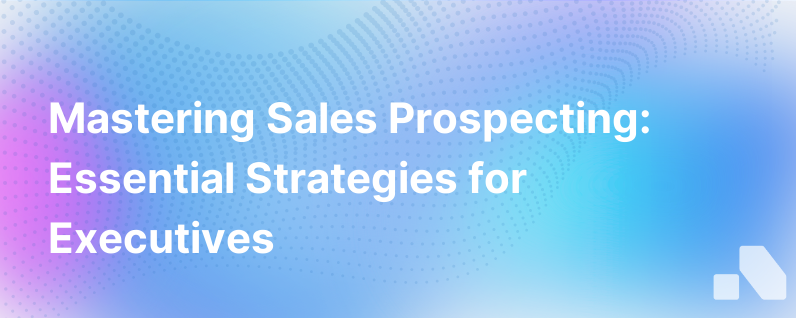
Sales prospecting – the lifeblood of any thriving business's sales pipeline is the proactive search for potential customers. It's a fundamental yet challenging process where the paradox of sales unfolds: to sell more, you must first find someone to sell to. Mastering the art of prospecting is a cornerstone for the growth and sustainability of any business, and in today's competitive B2B landscape, leveraging innovative approaches and methodologies is critical for success.
Understanding Sales Prospecting
Sales prospecting is more than just a preliminary phase in the sales process; it's a strategic expedition to identify and engage with potential customers (prospects) who have the potential or express a need for your product or service. It's about sifting through the myriad of businesses to pinpoint those who may eventually become paying customers. The landscape of prospecting has evolved over time, and today, it integrates a mix of traditional approaches and cutting-edge sales technologies.
Why Is Prospecting Important?
In the absence of effective prospecting, even the most eloquent sales pitches and well-constructed value propositions will echo in an empty room. Continuous prospecting ensures a steady flow of leads into your sales funnel, prevents revenue fluctuations, and allows for more predictable sales forecasts.
Challenges in Sales Prospecting
Despite its importance, sales prospecting is often the most challenging part of a salesperson's job. Challenges include:
- Identifying quality leads amidst an ocean of businesses
- Engaging prospects in a way that breaks through the noise
- Balancing prospecting activities with managing existing customer relationships
- Facing frequent rejection and still maintaining perseverance
Elements of Successful Sales Prospecting
-
Research and Targeting: The key to effective prospecting lies in thorough research and precise targeting. Sales reps need to harness the power of data analytics, market analysis, and customer profiling to identify prospects that resemble their ideal customer.
-
Outreach Strategies: Multi-channel outreach that includes phone calls, emails, social selling, and even direct mail ensures you cover all bases where your prospects might be.
-
Personalization: Prospects today expect personalized communication. Tailoring your pitch or message to resonate with the specific pain points or objectives of a potential buyer is no longer optional; it's mandatory.
-
Consistency and Discipline: Regular, disciplined prospecting activities are mandatory for keeping the pipeline full. This requires devising a schedule or utilizing technology to streamline and automate parts of this process.
-
Follow-Up: Often, the fortune is in the follow-up. Persistence in follow-ups, whilst ensuring not to encroach on prospects' tolerance, substantially increases the likelihood of conversion.
-
Tracking and Analyzing Performance: Keeping tabs on which prospecting strategies and channels are yielding the best results helps refine methods over time.
Crafting a Prospecting Blueprint
Executing a successful sales prospecting strategy starts with a blueprint - a clearly defined plan that outlines processes, identifies the tools needed, and measures outcomes. Here are the steps to follow:
Step 1: Develop Your Ideal Customer Profile (ICP)
Before you even consider reaching out to prospects, get crystal clear about who your ideal customer is. Analyze your existing customer base to identify common characteristics and challenges, including industry, company size, geographic location, and specific needs that your solution addresses.
Step 2: Build a List of Potential Prospects
Leverage multiple sources to create a list of prospects that match your ICP. This could include leveraging online business directories, LinkedIn, trade show attendee lists, and purchasing prospect lists from reputable providers. In today's digital world, software platforms, such as Aomni, can accelerate this process by aggregating and providing access to extensive databases of potential prospects with actionable insights.
Step 3: Connect and Engage With a Personal Touch
Once you have your list, it's time to reach out. This is where your creativity and personalization skills come into play. Use your research to craft compelling, custom-tailored messages that address specific business challenges, desires, or goals. Outreach should be multi-threaded, meaning it should occur through various touchpoints, such as email, phone calls, social media, and networking events.
Step 4: Qualify, Qualify, Qualify
As you begin to engage with prospects, your goal is to qualify them further. The BANT framework (Budget, Authority, Need, and Timing) is an excellent qualitative tool for gauging the fit and sales-readiness of a prospect.
Step 5: Schedule Discovery Calls or Meetings
Upon successful qualification, the next step is to schedule a discovery call or meeting. During this interaction, delve deeper into their business needs, the challenges they face, and explore how your solution could potentially solve their problems.
Step 6: Nurture and Follow-Up
After your initial meeting, the game is all about nurturing your prospects. Consistent follow-ups, providing additional value through resources, or sharing relevant market insights, are excellent ways to keep your solution top-of-mind and move the prospect further through the sales funnel.
Step 7: Measure and Refine
Analyze the outcomes of your prospecting efforts. What are your response rates? How many meetings are you setting up weekly? Use this data to refine your approach, targeting, and message. The world of sales is dynamic, and so should your prospecting strategy be.
Step 8: Leverage Technology to Scale Up
Incorporate sales enablement tools that help to automate and streamline the prospecting process: from CRM systems and email tracking software to AI-powered prospecting platforms like Aomni. Remember, scaling up does not mean losing the personal touch; it means doing it more efficiently.
Conclusion
Prospecting is not a one-off task but rather a continuous commitment. Navigating the intricate dynamics of identifying, connecting, and establishing relevant conversations with potential customers requires meticulous planning, execution, and persistence. As challenging as it may seem, refinements in your strategy, the incorporation of new technologies, and a commitment to personalizing each interaction can turn the daunting task of prospecting into a process that's both effective and rewarding.